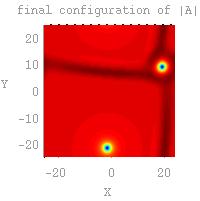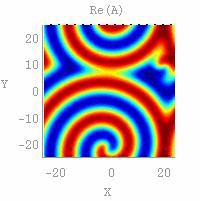

As one might expect, lifting the CGLE into two-dimensional space makes things significantly more complicated. In addition to quasi-1D versions of the coherent structures found in the one-dimensional CGLE, there are a variety of other coherent structures.
Along side two-dimensional analogues of defect and phase turbulence, solutions known as 'frozen states' are commonly observed. Such a state is illustrated here:
 in a square
container of side length 50. The left-hand and right-hand plots illustrate
the steady states of
in a square
container of side length 50. The left-hand and right-hand plots illustrate
the steady states of  and
and
 respectively.
respectively.
Hold the cursor over the right-hand plot to see the periodic motion of the spiral waves.
These solutions are composed of cellular structures which take the form of a stationary arrangement of spiral defects (where spirals are either emitted or disappear) surrounded by shocklines (another form of defect). The arrangement of these shocklines form the cellular pattern
Two movie (.avi) files are available here, illustrating the evolution
of  and
and
 in
selecting the above frozen state.
in
selecting the above frozen state.
| spirals-abs.avi (2.1MB) | |
| spirals-real.avi (2.1MB) |
From the first of these animations, one can clearly see that selection of the final state takes place over two time-scales: a fast scale where early transients die away and a slow scale where the spiral source defect (where the spirals are emitted from) slowly converges to its steady state.
For a complete review of the phase diagram for the two-dimensional CGLE, please refer to Chaté (1996).